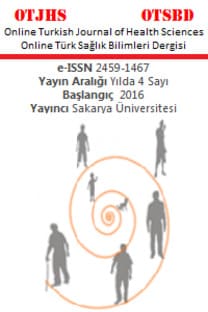Erysipelothrix rhusiopathiae’nın etken olduğu nadir bir osteomiyelit olgusu
Erysipelothrix rhusiopathiae, osteomiyelit, zoonoz, meslek hastalığı, yumuşak doku bozukluğu, osteomiyelit
A rare case of osteomyelitis caused by erysipelothrix rhusiopathiae
Erysipelothrix rhusiopathiae, zoonoses, occupational disease, soft tissue disorder, osteomyelitis,
___
- Kaynaklar1. Koch, R. Investigations into theetiology of traumatic infective diseases. New Sydenham Society, London 1880.
- 2. https://microbewiki.kenyon.edu/index.php/Erysipelothrix (Erişim: 01.06.2018)
- 3. Venditti M, Gelfusa V, Castelli F, Brandimarte C, Serra P. Erysipelothrix rhusiopathiae endocarditis Eur J Clin Microbiol Infect Dis 1990; 1: 50-2.
- 4. Grieco MH, Sheldon C. Erysipelothrix rhusiopathiae. Ann NY Acad Sci1970; 174: 523-532.
- 5. Robson JM, McDougall R, van der Valk S, Waite SD, Sullivan JJ. Erysipelothrix rhusiopathiae: An uncommon but ever present zoonosis Pathology 1998; 30: 391-4.6. Andrychowski J, Jasielski P, Netczuk T, Czernicki Z. Empyema in spinal canal in thoracicregion, abscesses in paravertebral space, spondylitis: in clinical course of zoonosis Erysipelothrix rhusiopathiae. EurSpine J 2012; 21: S557-563.
- 7. Elvy J, Hanspal I, Simcock P. A case of Erysipelothrix rhusiopathiae causing bilateral endogenous endophthalmitis. J Clin Pathol 2008; 61: 1223-1224.
- 8. Feasi M, Bacigalupo L, Cappato S, Pontali E, Usiglio D, Rollandi GA, Filauro M, Mori M, Cassola G. Erysipelothrix rhusiopathiae intra-abdominal abscess. Int J Infect Dis 2010; 14: e81-83.
- 9. Hardman SC, Carr SJ, Swann RA. Peritoneal dialysis-related peritonit is with bacteraemia due to Erysipelothrix rhusiopathiae. Nephrol Dial Transplant 2004; 19: 1340-1341.
- 10. Hocqueloux L, Poisson DM, Sunder S, Guilbert S, Prazuck T. Septic arthritis caused by Erysipelothrix rhusiopathiae in a prosthetic kneejoint. J Clin Microbiol 2010;48: 333-335.
- 11. Jones N, Khoosal M. Erysipelothrix rhusiopathiae septicemia in a neonate. ClinInfectDis 1997; 24: 511.
- 12. Kim SR, Kwon MJ, Lee JH, Lee NY. Chronic meningitis caused by Erysipelothrix rhusiopathiae. J Med Microbiol 2007; 56: 1405-1406.
- 13. Norman B, Kihlstrom E. Erysipelothrix rhusiopathiae septicemia. Scand J Infect Dis 1985; 17: 123-4.
- 14. Tan EM1, Marcelin JR1, Adeel N2, Lewis RJ2, Enzler MJ1, Tosh PK1. Erysipelothrix rhusiopathiae bloodstream infection - A 22-year experience at Mayo Clinic, Minnesota. 2017 Nov; 64(7): e65-e72.
- 15. K. Tolis1, S. Spyridonos1, S. Tsiplakou2 and E. Fandridis1 Tenosynovitis of a digit due to Erysipelothrix rhusiopathiae: case report and review of the literature New Microbes New Infect. 2015 Nov; 8: 128–130.
- 16. Mukhopadhyay C., Shah H., Vandana K.E., Munim F., Vijayan S. A child with Erysipelothrix arthritis beware of the little known. AsianPac J Trop Biomed. 2012; 2: 503–504.
- 17. Marc Romney, MD,1 Stephen Cheung, MD FRCPC,2 and Valentina Montessori, MD FRCPC2 Erysipelothrix rhusiopathiae endocarditis and presumed osteomyelitis Can J Infect Dis. 2001 Jul-Aug; 12(4): 254–256.
- 18. Gorby, G. L.,and J. E. Peacock, Jr. 1988. Erysipelothrix rhusiopathiae endocarditis: microbiologic, epidemiologic, and clinical features of an occupational disease. Rev. Infect. Dis. 10: 317-325.
- 19. Heilman, F. R. and W. E. Herrell. 1944. Penicillin in thetreatment of experimental infections due to Erysipelothrix rhusiopathiae. Proc. Staff Meet. Mayo. Clin. 19: 340-345.
- 20. Poretz, DM. 1985. Erysipelothrix rhusiopathiae, p. 1185-1186. In G. L. Mandell, R. G. Douglas, Jr.,and J. E. Bennett (ed.), Principles and practice of infectious diseases, 2nd ed. J. Wiley&Sons, Inc., New York.
- 21. Annette C, Rebolı and Edmund Farrar 1989 Erysipelothrix rhusiopathiae: An Occupational Pathogen. Clin Microbiol Rev 1989 Oct; 2(4): 354–359.
- ISSN: 2459-1467
- Yayın Aralığı: 4
- Başlangıç: 2016
- Yayıncı: Oğuz KARABAY
Meme kitle muayenesi: histopatolojik analiz
Motivasyonel görüşmenin çocuk ve adölesanlarda kullanımı
Erysipelothrix rhusiopathiae’nın etken olduğu nadir bir osteomiyelit olgusu
Tuğba AYHANCI, Hüseyin Agah TERZİ, Mehmet KÖROĞLU, Alper ERKİN, Mustafa ALTINDİŞ
Özen ÖZENSOY GÜLER, Tuğba UYSAL, Ender ŞİMŞEK, Ahmet ÇARHAN
Genç erişkinlerde yeme bağımlılığı ile dürtüsellik arasındaki ilişkinin incelenmesi
Atilla TEKİN, Ayşegül YETKİN, Çağla GÜRSOY
